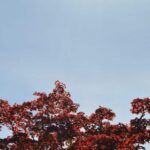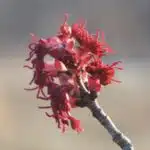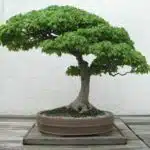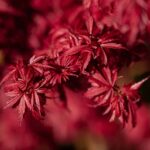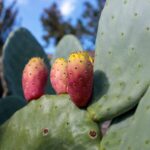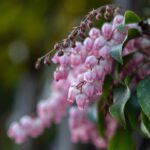The Red Dragon Japanese Maple, also known as Acer palmatum ‘Red Dragon,’ is a popular ornamental tree among horticultural enthusiasts and landscape designers alike. Its striking deep red foliage and delicate, yet sturdy structure make it an excellent addition to any garden or outdoor living space. However, growing and caring for this exquisite tree requires specific knowledge and attention to detail.
To successfully cultivate and maintain the Red Dragon Japanese Maple, one must understand its growing needs, including soil type, light requirements, and watering habits. Additionally, proper pruning techniques are crucial in maintaining the tree’s shape and promoting healthy growth. This article will provide comprehensive instructions on how to grow and care for Red Dragon Japanese Maple trees to ensure their long-lasting beauty in your garden or landscape design.
Understanding The Red Dragon Japanese Maple
Red Dragon Japanese Maple is a stunningly beautiful tree that is known for its unique foliage and vibrant color. It belongs to the Aceraceae family and is native to Japan. This slow-growing deciduous tree is well-suited for small gardens, patios, or as a focal point in larger landscapes.
When compared to other varieties of Japanese maple trees, Red Dragon stands out due to its deep red-colored leaves that turn burgundy in the fall season. Its leaves are deeply lobed and have serrated edges, which adds texture and interest to any landscape design. Moreover, this variety of maple tree can withstand partial shade and still maintain its rich red color.
The benefits of growing a Red Dragon Japanese Maple are plenty. Not only does it add a pop of color to your garden, but it also offers several uses such as creating an attractive border, screening unsightly areas or providing shade in the summer months. Aside from these benefits, this tree requires minimal maintenance and can be grown in containers if space is limited. With proper care and attention, your Red Dragon Japanese Maple will provide years of enjoyment and beauty to your landscape design.
When selecting the right location for your tree, it’s important to consider factors such as sunlight exposure and soil conditions. The next section will delve into these considerations in detail so that you can ensure optimal growth for your Red Dragon Japanese Maple Tree.
Selecting The Right Location For Your Tree
When selecting the right location for your red dragon Japanese maple, it is important to take into consideration its sun exposure requirements. This tree thrives in partial shade, meaning it needs at least four hours of direct sunlight per day but also requires protection from the scorching afternoon sun. It is best to plant the tree where it will receive morning sun and afternoon shade, such as on the east side of a building or under a canopy of taller trees.
Another factor to consider when choosing a location for your red dragon Japanese maple is soil acidity. This tree prefers acidic soil with a pH range between 5.5 and 6.5. If your soil is alkaline, you will need to adjust it by adding organic matter such as peat moss or elemental sulfur before planting the tree. It is also important to ensure that the soil has good drainage and is not prone to flooding or standing water.
By selecting a location that provides adequate sun exposure and ensuring proper soil acidity, you can provide an optimal environment for your red dragon Japanese maple to thrive in. In the subsequent section, we will discuss how to prepare the soil for planting this beautiful and unique tree species.
Preparing The Soil For Planting
According to research, the soil preparation is a crucial element in growing and caring for red dragon Japanese maple. The first step in preparing the soil is to remove any weeds or debris from the site. This will help avoid competition for nutrients and water between the newly planted tree and unwanted plants. Afterward, it is essential to dig a hole that is twice as wide as the root ball of the tree.
The second step in preparing the soil is to assess its nutrient requirements. Red dragon Japanese maple thrives well in well-drained soils that are rich in organic matter. To ensure your plant gets all the necessary nutrients, consider adding compost or aged manure before planting. Additionally, you may also incorporate some slow-release fertilizers that are high in nitrogen to enhance healthy foliage growth.
The final step of preparing the soil involves backfilling with soil mixed with compost or aged manure around the root ball of your red dragon Japanese maple tree. Ensure there are no air pockets left by gently pressing down on the soil with your hands or feet. Once done, water thoroughly but avoid overwatering, which can lead to root rot. With proper soil preparation techniques, your red dragon Japanese maple will grow healthy and thrive well without much hassle.
To continue nurturing your red dragon Japanese maple successfully, choosing the right container for potted trees is crucial.
Choosing The Right Container For Potted Trees
After preparing the soil, it is essential to choose the right container for your red dragon Japanese maple. The container plays a crucial role in providing adequate drainage and room for root growth. Choosing the wrong size or type of pot can lead to poor plant health and stunted growth. It is important to choose a container that is at least two sizes larger than the current root ball of your tree.
When selecting a container, consider both its size and drainage system. Containers come in various sizes, ranging from small pots for seedlings to large tubs for mature trees. The ideal container size for your red dragon Japanese maple will depend on its age and growth rate. Additionally, ensure that your chosen container has adequate drainage holes to prevent waterlogging, which can cause root rot.
Properly choosing the right container and ensuring proper drainage are integral components of caring for your red dragon Japanese maple tree. As you choose an appropriate sized pot with sufficient drainage holes, also consider where you intend to place the tree so as not to interfere with its growth or access to sunlight. With these factors in mind, you can now move onto watering your red dragon Japanese maple effectively.
Watering Your Red Dragon Japanese Maple
Proper watering is essential to keep your Red Dragon Japanese Maple tree healthy and thriving. Deep watering is the most effective way to water this tree, which will encourage strong root growth, leading to an overall healthier plant. Watering deeply allows the roots to absorb all the moisture they need, and it also helps the soil retain moisture for a more extended period.
Overwatering can cause serious damage to your Red Dragon Japanese Maple tree. Signs of overwatering include yellow or wilted leaves, moldy soil, and fungal growth on leaves or branches. If you notice these signs, it’s time to adjust your watering schedule. It’s better to underwater than overwater this tree because it thrives in well-drained soil.
Benefits of deep watering are numerous when it comes to maintaining a healthy Red Dragon Japanese Maple tree. Deep watering helps maintain soil moisture levels by encouraging roots to reach deeper for water, which strengthens them and makes them more resilient against drought conditions. Additionally, deep watering ensures that nutrients are distributed evenly throughout the soil, promoting optimal growth and development of your tree.
To ensure optimal growth for your Red Dragon Japanese Maple tree, proper fertilization is key. Fertilizing provides essential nutrients like nitrogen and phosphorus that help promote healthy foliage growth and root development. In the next section, we’ll discuss how to fertilize your tree for optimal growth without causing harm or damage.
Fertilizing Your Tree For Optimal Growth
- When fertilizing a red dragon japanese maple, it is important to choose a fertilizer that is specifically formulated for trees, shrubs, and evergreens.
- Depending on the age and size of the tree, fertilizer should be applied at least once a year during the growing season.
- Slow-release fertilizers should be used as they provide longer-lasting nutrients and are less likely to burn the tree’s roots.
- The amount of fertilizer used should be determined based on the tree’s size, soil type, and other environmental factors.
Types Of Fertilizer
Fertilizing your Red Dragon Japanese Maple is essential for healthy growth and vibrant foliage. Different types of fertilizer can provide the necessary nutrients for optimal growth. Nitrogen-rich fertilizers such as ammonium sulfate and urea are excellent choices for promoting leafy growth, while phosphorus-rich fertilizers like bone meal and rock phosphate encourage root development.
When applying fertilizer to your Red Dragon Japanese Maple, it’s crucial to follow the instructions provided by the manufacturer. Over-fertilization can lead to burnt roots or scorched leaves, which can be detrimental to the health of your tree. To avoid this, apply fertilizer in early spring before new growth appears or in late fall after leaf-drop. Ensure that the fertilizer is evenly spread around the base of your tree and water thoroughly after application.
Organic fertilizers like compost or well-aged manure are also excellent options for feeding your Red Dragon Japanese Maple. These types of fertilizers provide a slow-release of nutrients over time, ensuring that your tree receives a consistent supply of food throughout the growing season. They also improve soil structure and promote beneficial microorganisms that help maintain healthy soil conditions, promoting overall plant health. Incorporating organic matter into the soil around your tree at least once a year will help maintain its health and vitality for years to come.
Frequency Of Fertilizing
Maintaining the health of your Red Dragon Japanese Maple requires proper fertilization. In addition to choosing the right type of fertilizer, it’s essential to consider the frequency of application. The frequency of fertilizing depends on various factors such as soil composition and the type of fertilizer used. As a horticulturalist or landscape designer, you need to understand the importance of regular fertilization for healthy growth.
The frequency of fertilizing your Red Dragon Japanese Maple largely depends on whether you use organic or synthetic fertilizers. Organic fertilizers provide a slow-release of nutrients over an extended period, making them ideal for long-term feeding. You can apply organic matter at least once a year to improve soil structure and promote beneficial microorganisms that help maintain healthy soil conditions. On the other hand, synthetic fertilizers are fast-acting and require frequent applications throughout the growing season.
When using synthetic fertilizers, it’s crucial to follow manufacturer instructions carefully and avoid over-fertilizing your tree. Applying too much fertilizer can lead to burnt roots or scorched leaves, which can be detrimental to its health. For optimal results, apply synthetic fertilizer in early spring before new growth appears or in late fall after leaf-drop. However, if you prefer organic options, incorporating compost or well-aged manure into the soil around your tree at least once a year will help maintain its health and vitality for years to come.
Pruning Techniques For Shape And Health
Pruning is an essential part of maintaining the overall health and aesthetic appeal of your Red Dragon Japanese Maple. The right pruning frequency can help to keep the tree healthy, while shaping techniques can help you achieve the desired look. Pruning should be done annually during the dormant season, typically in late winter or early spring.
When it comes to pruning frequency, it’s important to strike a balance between removing enough growth to maintain the tree’s shape and not over-pruning, which could damage the tree. A good rule of thumb is to remove no more than one-third of the tree’s crown each year. This will ensure that you’re keeping the tree in good shape without causing undue stress.
Shaping techniques are also important when pruning your Red Dragon Japanese Maple. These can include removing branches that are growing in an undesirable direction, thinning out crowded areas, and cutting back any dead or damaged limbs. By using these techniques, you can help to create a beautiful and healthy tree that will thrive for years to come.
To propagate your Red Dragon Japanese Maple, there are several steps you can take. One option is to take cuttings from a mature tree and root them in soil or water. Another option is to layer branches by bending them down into soil and allowing them to root while still attached to the parent plant. With proper care and attention, you can easily grow new trees from your existing Red Dragon Japanese Maple.
Propagating Your Red Dragon Japanese Maple
After learning about the proper pruning techniques for shaping and maintaining the health of your red dragon Japanese maple, it’s time to focus on propagation. Propagation is a way to create new plants from existing ones, which can be useful for expanding your garden or sharing with others. The rooting process for a red dragon Japanese maple involves taking cuttings from the tree and encouraging them to form roots.
To begin the rooting process, choose a healthy branch that is at least six inches long and has several sets of leaves. Remove any leaves from the bottom inch of the cutting, and dip the cut end in rooting hormone powder. Place the cutting in a container filled with moistened potting soil, and cover it with a plastic bag to create a humid environment. Keep the container in a warm, bright location out of direct sunlight.
After about four weeks, check the cutting for root development by gently tugging on it. If you feel resistance, roots have begun to form. Once roots are visible through the drainage holes in the bottom of the container, you can transplant your new red dragon Japanese maple into its own pot or into your garden bed. With these pruning tips and rooting processes in mind, you can successfully propagate your own red dragon Japanese maples and enjoy their stunning beauty throughout your landscape design.
Moving forward, dealing with pests and diseases is an important aspect of caring for your red dragon Japanese maple. These trees are susceptible to aphids, spider mites, powdery mildew, and fungal infections like verticillium wilt. In our next section, we will explore how to identify these issues and provide solutions for keeping your red dragon Japanese maple healthy and thriving.
Dealing With Pests And Diseases
It is important to note that the Red Dragon Japanese Maple is a relatively pest-resistant tree. However, like any plant species, it may still be susceptible to certain pests and diseases. It is crucial to identify these problems early on so that they can be treated promptly.
One natural remedy for controlling pests on the Red Dragon Japanese Maple is using insecticidal soap. This solution can be made by diluting a small amount of dish soap in water and spraying it onto the affected area. Another effective natural method is introducing beneficial insects, such as ladybugs or lacewings, into your garden. These insects feed on harmful pests and can help keep your tree healthy.
If natural remedies do not work or if the problem is severe, chemical treatments may be necessary. However, it is essential to use caution when applying chemicals as they may harm beneficial insects and other plants in your garden. Before applying any chemical treatment, research the specific product and follow instructions carefully.
Moving forward with proper care techniques will ensure a healthy Red Dragon Japanese Maple tree for years to come. Now that we have covered how to deal with pests and diseases, our subsequent section will focus on winterizing your tree to protect it from harsh weather conditions.
Winterizing Your Tree
- Pruning of Red Dragon Japanese Maples should be done in late winter or early spring when temperatures are mild and the tree is in a dormant state.
- Mulching should be done to provide a layer of insulation and protect the roots from temperature fluctuations.
- Watering should be done regularly to keep the tree from drying out and to prevent it from becoming stressed.
- Fertilizer should be applied in the spring to encourage healthy growth and promote blooming.
- Avoid over-pruning, which can cause damage and weaken the tree.
- Winterizing your Red Dragon Japanese Maple will help ensure its long-term health and beauty.
Pruning
To maintain the health and beauty of your Red Dragon Japanese Maple, pruning is an essential task that should not be overlooked. Pruning helps control the tree’s growth and shape, eliminates diseased or damaged branches, and encourages new growth. Before pruning your maple, it is important to sharpen your shears to ensure a clean cut that promotes faster healing.
The timing of pruning can greatly affect the health of your tree. It is recommended to prune in late winter or early spring while the tree is still dormant. During this time, it is easier to see the structure of the tree without leaves and any damage from winter weather can be addressed before new growth begins. Avoid pruning during the summer months as this can leave open wounds susceptible to insect infestation and disease.
When pruning, start by removing dead or diseased branches first. Next, remove any branches that are crossing or rubbing against each other as they can cause damage over time. Finally, selectively prune any branches that are detracting from the desired shape of the tree. Remember to make clean cuts at a slight angle just above a bud or branch junction for optimal healing. With proper timing and technique, regular pruning will enhance the health and beauty of your Red Dragon Japanese Maple for years to come.
Mulching
As winter approaches, it is important to take steps to protect and prepare your Red Dragon Japanese Maple for the colder months. One effective way to do this is by using mulch around the base of the tree. Using mulch provides several benefits, including insulating the roots from extreme temperatures, retaining moisture in the soil, and preventing weed growth.
When selecting a type of mulch, it is important to choose one that is organic and will decompose over time, such as bark chips or shredded leaves. Apply a layer of mulch about 2-3 inches thick around the base of the tree, making sure to leave a small space between the trunk and the mulch to prevent moisture buildup.
It is best to apply mulch in late fall after the tree has gone dormant for the winter. This will give ample time for the soil to absorb moisture before freezing temperatures set in. With proper use of mulching, you can help ensure that your Red Dragon Japanese Maple stays healthy and strong through even the harshest of winter weather.
Watering
As a horticulturalist or landscape designer, it is crucial to educate homeowners on the proper techniques for winterizing their trees. In addition to using mulch, watering is another key factor in preparing your Red Dragon Japanese Maple for the colder months ahead. It is important to maintain a consistent watering frequency and ensure proper drainage to prevent water from accumulating around the roots.
During the winter, trees may require less frequent watering due to lower temperatures and reduced sunlight. However, it is still important to monitor soil moisture levels and provide water when necessary. A general rule of thumb is to water deeply once a week, allowing the soil to dry slightly between each watering. This will help prevent overwatering or underwatering, both of which can be harmful to your tree.
Proper drainage is also essential in preventing root rot and other moisture-related issues during the winter months. Make sure that your Red Dragon Japanese Maple is planted in well-draining soil and that excess water can easily flow away from the roots. By following these watering guidelines and ensuring proper drainage, you can help protect your tree from winter damage and promote healthy growth in the spring.
Common Mistakes To Avoid
One of the most common mistakes that people make when caring for red dragon Japanese maples is over watering. These trees are sensitive to excess moisture, and their roots can quickly become waterlogged if they are not properly drained. To avoid this issue, it is important to ensure that your tree is planted in well-draining soil and that you only water it when the top inch of soil feels dry.
Another mistake that people often make is using improper pruning techniques. This can be especially damaging to a red dragon Japanese maple, as these trees require careful shaping and maintenance in order to thrive. When pruning your tree, be sure to use sharp, clean tools and cut at an angle just above a bud or branch junction. Avoid cutting back more than one-third of the tree’s growth at a time, as this can stress the plant and lead to stunted growth.
By avoiding these common mistakes and taking care to provide your red dragon Japanese maple with the proper growing conditions and maintenance, you can enjoy a healthy, vibrant tree for years to come. However, there are still many questions that may arise about the care of these unique plants. In the following section, we will address some of the most frequently asked questions about red dragon Japanese maples to help you better understand how to care for them in your own landscape.
Frequently Asked Questions About Red Dragon Japanese Maple
Red Dragon Japanese Maple is a versatile tree that can thrive in different environments. However, it is essential to note that some common misconceptions surround its growth and care. For instance, many people believe that this tree requires full sun exposure to flourish. However, this is not true since the Red Dragon Japanese Maple prefers partial shade or filtered light.
Another misconception about this tree is that it requires a lot of pruning to maintain its shape and size. While pruning may be necessary, especially during the first few years of growth, excessive trimming can harm the tree’s overall health. Therefore, it is crucial to prune only when necessary and use proper techniques to avoid damaging the branches or trunk.
The Red Dragon Japanese Maple complements various plants in a garden setting. Some of the best companion plants for this tree include Hostas, Bleeding Hearts, Ferns, and Astilbes. These plants have similar light requirements as the Red Dragon Japanese Maple and create an appealing contrast with their foliage colors and textures. When selecting companion plants for your garden, ensure that they do not compete for nutrients or sunlight with the Red Dragon Japanese Maple.
Transition: Now that you know some common misconceptions about growing and caring for Red Dragon Japanese Maples let’s explore whether these trees can grow in full sun conditions without compromising their health and vigor.
Can Red Dragon Japanese Maple Trees Grow In Full Sun?
Frequently Asked Questions about Red Dragon Japanese Maple have covered various topics related to the growth and care of this stunning tree. However, one question that often comes up is whether Red Dragon Japanese Maple trees can grow in full sun. The answer is yes, but there are both benefits and drawbacks to growing this tree in such conditions.
One of the benefits of growing a Red Dragon Japanese Maple in full sun is that it will develop more vibrant colors. When exposed to direct sunlight, these trees tend to produce deeper red hues on their leaves that make them even more strikingly beautiful. Additionally, full sun exposure helps promote healthy growth by providing ample light for photosynthesis, which leads to stronger trunks and branches.
On the other hand, one major drawback of growing Red Dragon Japanese Maple trees in full sun is that they may experience leaf scorching during hot summer days. This can happen when the leaves lose too much moisture due to excessive heat and sunlight exposure. To prevent this from happening, you should provide some shade or cover for your tree during times of extreme heat or drought. Alternatively, you can choose to grow your Red Dragon Japanese Maple in partial shade or filtered sunlight for optimal growth without risking leaf damage.
Now that we know more about the benefits and drawbacks of growing a Red Dragon Japanese Maple tree in full sun, it’s important to consider alternative growing conditions before making a final decision. In fact, many horticulturalists recommend planting these trees in well-draining soil with plenty of organic matter and mulch for optimal growth. Furthermore, providing consistent moisture levels through regular watering and fertilization will help ensure healthy growth throughout the year regardless of sunlight exposure.
As we move forward into our next topic on how fast a Red Dragon Japanese Maple grows, it’s important to remember that proper care and attention will play a crucial role in promoting optimal growth rates for this beautiful tree species. By understanding its unique needs and preferences as well as the benefits and drawbacks of different growing conditions, you can help your Red Dragon Japanese Maple thrive in any environment.
How Fast Does A Red Dragon Japanese Maple Grow?
The Red Dragon Japanese Maple is a popular ornamental tree known for its stunning foliage and striking red color. It grows at a moderate rate of approximately 1 to 2 feet per year, with the potential of reaching 10 to 15 feet tall and wide in ten years. This growth rate may vary depending on soil quality, climate conditions, and other factors.
To ensure proper growth and development of the Red Dragon Japanese Maple, regular maintenance is crucial. The tree should be planted in well-draining soil that is rich in organic matter. It requires partial shade to full sun exposure, but it should be protected from strong winds that can damage its delicate branches. Pruning should be done during the dormant season to promote healthy growth and maintain its desired shape.
In summary, the Red Dragon Japanese Maple grows at a moderate pace, with an average rate of 1 to 2 feet per year. Proper maintenance techniques such as planting it in well-draining soil, providing partial shade to full sun exposure, protecting it from strong winds, and pruning during the dormant season are essential for its optimal growth and development. With these tips in mind, homeowners can enjoy the beauty of this majestic tree for years to come.
Can Red Dragon Japanese Maple Trees Be Grown Indoors?
As we learned in the previous section, a Red Dragon Japanese Maple can grow up to 10 feet tall and wide, with an average growth rate of one to two feet per year. However, this growth rate can vary depending on the growing conditions. The tree thrives in partial shade or full sun and requires well-draining soil that is rich in organic matter.
To care for a Red Dragon Japanese Maple, it is essential to keep the soil moist but not waterlogged. Overwatering can lead to root rot, which is one of the potential challenges when growing this tree. Another challenge is its susceptibility to pests such as aphids and spider mites. Regular inspection and treatment with insecticides or neem oil can help prevent infestations.
While it is possible to grow Red Dragon Japanese Maples indoors, it is more challenging as they require adequate light and humidity levels. It is best to grow them outdoors in suitable growing conditions where they can thrive and reach their full potential. With proper care and attention, a Red Dragon Japanese Maple can be a beautiful addition to any garden or landscape design project.
Frequently Asked Questions
What Is The Average Lifespan Of A Red Dragon Japanese Maple Tree?
The average lifespan of a Red Dragon Japanese Maple tree is a matter of concern for many horticulturalists and landscape designers. Ironically, it can be said that the lifespan of this tree depends on how well it is cared for. Pruning techniques play a vital role in increasing its longevity. It is recommended to prune the tree in late winter or early spring when it is dormant. This helps in removing dead or diseased branches and encourages new growth. Soil requirements are equally important as the tree prefers well-drained, slightly acidic soil rich in organic matter. Maintaining proper watering habits ensures that the roots receive sufficient moisture without causing waterlogging. With adequate care, a Red Dragon Japanese Maple can live up to 50-75 years, making it a worthy addition to any landscape design project.
Is It Necessary To Cover The Tree During Winter Months?
Winter protection is crucial for the longevity of any tree, including the Red Dragon Japanese Maple. As a horticulturalist or landscape designer, it is important to educate homeowners on the importance of protecting their trees during harsh winter weather conditions. To ensure that your Red Dragon Japanese Maple thrives, it is recommended to cover it with burlap or frost cloth and mulch around its base to insulate its roots. It is also important to note that this tree has a slow growth rate, so taking extra precautions during the winter months will help to preserve its growth and overall health in the long run. By providing proper winter protection for your Red Dragon Japanese Maple, you are serving not only your own desire for a beautiful landscape but also preserving the legacy of a magnificent tree for many years to come.
How Do You Prevent Leaf Scorch On A Red Dragon Japanese Maple?
To prevent leaf scorch on a Red Dragon Japanese Maple, it is important to maintain proper watering frequency and ensure that the soil acidity is within the ideal range for this type of tree. Leaf scorch can occur when the tree is not receiving enough water or when the soil is too acidic, causing the leaves to dry out and turn brown around the edges. To avoid this issue, it is recommended to water the tree deeply once or twice a week during dry spells and to test the soil regularly to ensure that it has a pH between 5.5 and 6.5. Additionally, providing some shade during hot summer months can also help prevent leaf scorch and keep your Red Dragon Japanese Maple looking healthy and vibrant.
Can Red Dragon Japanese Maple Trees Be Used For Bonsai?
As ironic as it may seem, the vibrant and eye-catching Red Dragon Japanese Maple tree, with its fiery red leaves, is not ideal for bonsai enthusiasts. While it can certainly be pruned to maintain a smaller size, the tree’s delicate nature requires a certain level of care that may make it difficult for beginners to manage. However, for those with experience in cultivating such trees, proper pruning techniques and soil requirements can help ensure success. It is important to use well-draining soil and to prune regularly to control growth and shape the tree. With patience and dedication, the Red Dragon Japanese Maple can be transformed into a stunning bonsai specimen.
What Is The Best Time Of Year To Plant A Red Dragon Japanese Maple Tree?
The best time of year to plant a red dragon Japanese maple tree is in the fall or early spring. This allows the tree to establish its root system before experiencing the stress of extreme temperatures. When planting, it is important to choose a location with well-draining soil that is slightly acidic, and to incorporate organic matter into the soil prior to planting. In addition, mulching around the base of the tree can provide numerous benefits such as reducing weed growth, conserving moisture and regulating soil temperature. The ideal mulch for this type of maple is one that is organic and slow-decomposing, like shredded bark or wood chips. Properly caring for a red dragon Japanese maple will result in an eye-catching focal point in any landscape design.
Conclusion
Red Dragon Japanese Maple trees are a stunning addition to any garden or landscape. With proper care and attention, these trees can grow to reach heights of up to 12 feet and live for several decades. It is important to note that the lifespan of a Red Dragon Japanese Maple tree can vary depending on factors such as soil quality, climate, and overall care.
During the winter months, it is recommended to cover the tree with burlap or other protective material to prevent damage from harsh weather conditions. Leaf scorch can be prevented by ensuring that the tree receives adequate water and is not exposed to direct sunlight during hot summer months.
While Red Dragon Japanese Maple trees can certainly be used for bonsai, it is important to note that they require specific care and attention in order to thrive in this setting. The best time of year to plant a Red Dragon Japanese Maple tree is typically in early spring or fall when temperatures are mild and rainfall is abundant.
As a horticulturalist or landscape designer, it is essential to understand the unique needs of each plant species in order to create a thriving and sustainable garden or landscape. By incorporating Red Dragon Japanese Maple trees into your design plans, you can add a stunning pop of color and texture while also providing important ecological benefits such as air purification and shade coverage. With proper care and attention, these trees can continue to provide beauty and enjoyment for many years to come.
Image Credits
- “big red dragon” by doubleyou_em (featured)



